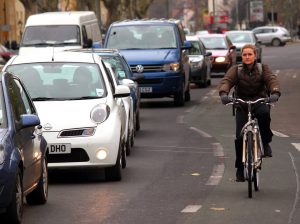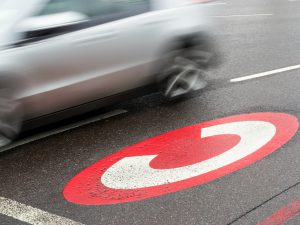All diesel and petrol vehicles will be banned from the centre of Oxford, a town in south-east England, under plans unveiled by the city’s leaders. The drastic move is a response to high levels of nitrogen dioxide (NO2), which despite being harmful to human health has plateaued above legal limits in some areas in recent years.
Oxford’s proposals are part of a wider trend that has seen several European cities, including Paris, Oslo and Madrid, announce plans to restrict or ban cars with combustion engines. Such schemes could help boost demand for electric vehicles, which would help to reduce their cost and accelerate the global transition away from fossil fuels, which contribute to climate change and lead to premature deaths.
Julia Hildermeier, clean vehicles and e-mobility officer for Brussels-based transport campaigners Transport and Environment (T&E), says: “What we need to clean up traffic and transport is to get more electric vehicles in the market, including buses, taxis and delivery vehicles. Oxford’s zone will be an effective tool to drive the supply of zero emissions vehicles.”
To take these schemes one step further, cities could integrate ride sharing services such as Uber into their plans, so that both congestion and air pollution can be tackled simultaneously. “If you combine the new technology with the new mode of use you have the perfect formula,” says Hildermeier.
Health risks
The announcement of the scheme coincided with a landmark report in the medical journal The Lancet on the impact of pollution on people’s health and the environment. It combined data from the World Health Organisation (WHO) that found air pollution was the biggest killer globally, leading to heart disease, stroke, lung cancer and other illnesses. Outdoor air pollution, largely from vehicles and industry, caused 4.5 million deaths a year, while in Southeast Asia, where impacts are acute, air pollution deaths are on track to double by 2050, said the report commissioners.
Studies on the impacts of NO2, which is concentrated in the exhaust fumes of diesel and petrol vehicles, show an effect on children’s lung growth. It’s also linked to heart disease, lung disease and sleep apnea but much is still unknown about its impacts on human tissue such as the brain.
T&E is pushing the European Union to introduce minimum quotas for car manufacturers to produce and sell zero emission vehicles, similar to those in California and China. Oxford’s plans send a strong message to manufacturers that they need to make the shift now. Hildermeier says these could be further backed by government subsidies to encourage the adoption of cleaner vehicles.
Oxford’s plans
If the scheme gets the go ahead following consultation, it will be implemented in stages, starting in 2020 with taxis, cars, light commercial vehicles and buses in a small number of streets in the core of the city. The size of the zone covered by the rules would be scaled up in 2025 and again in 2030. By 2035 heavy goods vehicles would also be banned from the area.
Oxford city and county councils have been spurred into action by their latest air quality monitoring data, which found that pollution has plateaued above the legal limits in some parts of the city. Between 2011 and 2013, average NO2 levels across the city centre fell by 18.9%, but between 2014 and 2016 they fell by just 3.9%.
The zero emission zone’s proponents have estimated that if it is implemented, NO2 levels in Oxford city centre would be slashed. Its most polluted street, which has NO2 levels of 61µg/m3, would fall by 74% to well below the 40µg/m3 limit set by European Union law.
Councillor John Tanner, Oxford City Council member for the environment, says that the zero emission zone would provide the step change that the city needs to rid itself of air pollution.
“All of us who drive or use petrol or diesel vehicles through Oxford are contributing to the city’s toxic air. Everyone needs to do their bit – from national government and local authorities, to businesses and residents – to end this public health emergency,” he says.
To support the scheme, councils are considering reduced parking fees for electric vehicles, electric-only taxi ranks and electric delivery vehicle-only loading areas. It could also levy a charge on workplace parking to discourage commuting by car or a congestion charge, similar to that in London. The city already has a low emission zone, which restricts the most polluting buses, a park-and-ride scheme to discourage cars entering the city centre, and high levels of cycling.
The city would also need to install more charging infrastructure for all types of electric vehicle. Earlier this year, the city council won £500,000 (4.4 million yuan) of government funding to install charging points for electric taxis and £800,000 (7 million yuan) for electric vehicle charging points for residents.
Facing up to challenges
The proposals are contingent on vehicle technology being sufficiently developed. Senior managers at bus companies Stagecoach and the Oxford Bus Company said that they supported the scheme in principle, but cautioned that zero emission bus technology was still in its infancy in the UK.
Tanner is undeterred by technology challenges: “Technology is advancing by leaps and bounds and the switch to electric vehicles will be quicker than most of us imagine.”
The switch to electric vehicles will be quicker than most of us imagine
Split support
A much bigger challenge, he believes, will be convincing people that they can make the changes and that they can have an even better city centre as a result.
“About half the people who’ve responded to the consultation so far have said that they’re against the scheme and that it’s a dreadful infringement of the right to drive their fossil fuel car where they want. The other half have said it’s an excellent idea that is long overdue, and want us to do it straight away,” he says.
There has also been criticism from those who believe that the scheme does not go far or fast enough.
Keith Taylor, Green Party MEP for Oxford and a member of the European Parliament’s Transport and Environment Committee, welcomed the proposals but said that it was difficult to take them seriously considering other plans by the council to expand car parking in the city centre and reduce charges. “These plans will increase traffic, congestion and pollution in the already worst affected areas of the city,” he says.
But Tanner responds: “The plans are not about reducing the number of cars in the city centre, rather making sure that the cars that are allowed are clean.”
Marcus Manning, business developer at urban innovation centre Future Cities Catapult, said that the phased implementation of the zone would go a long way in helping locals accept it. “But they need to make sure they are bringing people with them. Citizens need to understand what changes are being made and how these benefit them,” he says.
“You can’t just stop people doing something; they need to see that there is an alternative that has an upside.”








